History & Culture
A Brief History
by Eleanor B. Hawkins, Former Clerk of the Circuit Court
The first Europeans to enter what was to become Jefferson County were the members of Panfilo de Narvaez's expedition. They passed through an Apalachee town in 1528. In the 17th century, the Franciscans administered five missions in the county along an east-west line near what would become U.S. Highway 27. These missions were destroyed at the beginning of the 18th century by the English governor of South Carolina in retaliation against Spanish depredations. When American settlers entered the county in the 19th century, the land was occupied not by the Apalachees, who had been dispersed when the missions were abandoned, but by Miccosukees, a branch of the Creeks who became part of the Seminole group.
Florida was ceded by Spain to America in 1818. Settlement of Jefferson County was spurred both by its proximity to Tallahassee, the newly selected capital, and by the suitability of its soil for cotton cultivation. Early settlers bought large tracts of virgin forest, or, if they could, the old fields of the Indians. They cleared this land to plant cotton.
Jefferson County was separated from Leon County in 1827. The county, named for Thomas Jefferson, was established January 6, 182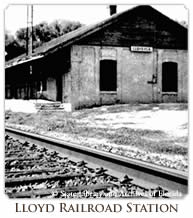 7. Monticello, named for Jefferson's Virginia home, was named county seat before statehood, while Florida was a territory of the United States. Monticello remains the county's only incorporated city. Robison's Post Office was named its county seat, superseding the older settlement of Waukeenah. The county seat was soon renamed Monticello. The county quickly acquired its first school, the Jefferson Academy, and a courthouse. Its prosperity suffered in the late 1830's when many of the settlers went to fight in the Seminole War. The failure of the Union Bank in Tallahassee also affected the county. In the 1850's, county residents who had been endeavoring to make the Wacissa and Aucilla Rivers navigable by canals adopted the railroad instead as their means of transportation. The arrival of the train at Station Number Two signaled the birth of Lloyd, which prospered with the railroads until the 1930's. The railroad also gave a boost to Aucilla, but Monticello was left stranded three miles north of the main track.
7. Monticello, named for Jefferson's Virginia home, was named county seat before statehood, while Florida was a territory of the United States. Monticello remains the county's only incorporated city. Robison's Post Office was named its county seat, superseding the older settlement of Waukeenah. The county seat was soon renamed Monticello. The county quickly acquired its first school, the Jefferson Academy, and a courthouse. Its prosperity suffered in the late 1830's when many of the settlers went to fight in the Seminole War. The failure of the Union Bank in Tallahassee also affected the county. In the 1850's, county residents who had been endeavoring to make the Wacissa and Aucilla Rivers navigable by canals adopted the railroad instead as their means of transportation. The arrival of the train at Station Number Two signaled the birth of Lloyd, which prospered with the railroads until the 1930's. The railroad also gave a boost to Aucilla, but Monticello was left stranded three miles north of the main track.
The Civil War broke out while the county was still burdened by its heavy railroad debt. In the war's aftermath, county planters struggled with debt and fluctuating cotton profits. Within a few years, farmers and store owners all found themselves trapped in the endless cycle of credit, which characterized sharecropping.
In the 1880's, farmers began looking for other crops. William Cirardeau sent out the first shipment of watermelon seed in 1882, and 40 years later, Jefferson County produced 80 percent of the world's supply. The Le Conte pear was also produced, but pecan were a larger cash crop. The flatwoods in the southern part of the county supplied both turpentine and lumber.
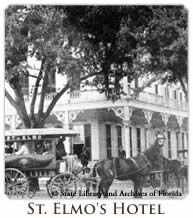 While Jefferson County held its own in agriculture after the Civil War, it failed to gather a large share of the new tourist trade. However, northerners did come to spend their winters at St. Elmo's Hotel in Monticello or to fish at the head of the Wacissa, but their role in the county's economy was ultimately not that of the tourist. After the agricultural depression of the 1920's several winter visitors bought up vast tracts of Jefferson County to use as hunting preserves.
While Jefferson County held its own in agriculture after the Civil War, it failed to gather a large share of the new tourist trade. However, northerners did come to spend their winters at St. Elmo's Hotel in Monticello or to fish at the head of the Wacissa, but their role in the county's economy was ultimately not that of the tourist. After the agricultural depression of the 1920's several winter visitors bought up vast tracts of Jefferson County to use as hunting preserves.
When the county was established in 1827, the log home of John G. Robison, which served as post office, was selected as seat of government. A two-story frame courthouse, begun in 1834 and completed in 1841, served the county for about 70 years.
 The current County Courthouse was built just after the beginning of the 20th century, when the county population was about 17,000. In November, 1908, voters approved a $35,000 bond issue to construct a courthouse. E.C. Hosford, architect of Eastman, Ga., and Bartow, Fla., designed the building after the style of Thomas Jefferson's Monticello, in classic revival style with French influence. Mutual Construction Company of Louisville, Ky., constructed the building. It is built of poured concrete slabs with interior walls one foot thick. Three vaults with walls eighteen inches thick are located in various offices. Floors are pine and ceramic tile. There are four chimneys with three fireplaces each, which burned coal. Two big pot-bellied coal burning stoves were used to heat the courtroom. The Courthouse was dedicated in 1910. It housed courts and all county offices, including school administration. The Courthouse is located at the intersection of US Highways 19 and 90.
The current County Courthouse was built just after the beginning of the 20th century, when the county population was about 17,000. In November, 1908, voters approved a $35,000 bond issue to construct a courthouse. E.C. Hosford, architect of Eastman, Ga., and Bartow, Fla., designed the building after the style of Thomas Jefferson's Monticello, in classic revival style with French influence. Mutual Construction Company of Louisville, Ky., constructed the building. It is built of poured concrete slabs with interior walls one foot thick. Three vaults with walls eighteen inches thick are located in various offices. Floors are pine and ceramic tile. There are four chimneys with three fireplaces each, which burned coal. Two big pot-bellied coal burning stoves were used to heat the courtroom. The Courthouse was dedicated in 1910. It housed courts and all county offices, including school administration. The Courthouse is located at the intersection of US Highways 19 and 90.
The building was "modernized" in 1968, but little structural changes have made in the 1908 design. Much of the original oak courtroom furniture is still in use including the judge's bench and the jury box.
Historical Sites & Tour
The Chamber of Commerce offers guided tours of the historic district of Monticello and sites throughout the County. Tours leave the Chamber office, 420 West Washington Street, 2 blocks west of the Courthouse, Monticello, at 1:30, Friday afternoons. Reservations are suggested; call (850) 997-5552 for reservations and additional information.
The Aucilla River Prehistory Project
Meandering from its headwaters in Georgia toward the Gulf of Mexico the Aucilla River defines the southeastern boundary of Jefferson county. The river and it's drainage system have served as a geologic and hydrologic platform for floral, faunal and human cultural development throughout prehistory. Since 1983 the Aucilla River Prehistory Project (ARPP) has been exploring the scientific aspects of these momentous events in the evolution of Florida's present-day "Big Bend" region.
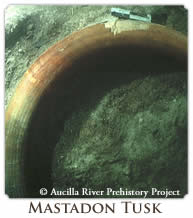 Sponsored by the Florida Museum of Natural History (FLMNH), and funded by National Geographic Society, Florida Department of State, Division of Historic Resources and many private benefactors the project has discovered numerous early man sites in the Aucilla River drainage. This ongoing research is conducted both above and below the waterline, utilizing diving techniques to explore the rich riverbottom sediments as well as the upland components of these sites.
Sponsored by the Florida Museum of Natural History (FLMNH), and funded by National Geographic Society, Florida Department of State, Division of Historic Resources and many private benefactors the project has discovered numerous early man sites in the Aucilla River drainage. This ongoing research is conducted both above and below the waterline, utilizing diving techniques to explore the rich riverbottom sediments as well as the upland components of these sites.
Under the direction of FLMNH Curator of Vertebrate Paleontology Dr. S. David Webb and ARPP has uncovered paleobotanical, paleontological and archaeological evidence indicating that some of the New World's earliest colonists arrived in this region over ten thousand years ago. Riverbottom sediments dating back 40,000 years yield valuable clues to understanding the more distant past.
For several millions of years what later came to be Jefferson county was home to mammoths, mastodons, ground sloths, giant armadillo, camels, horses, giant tortoise and saber cats. Skeletal remains of these and many other exotic animals are routinely recovered by ARPP field expeditions from the Aucilla's rich sedimentary legacy. Sands, clays, gravels and botanical material deposited since the last Ice Age over ten thousand years ago often produce items never found in more ancient accumulations - stone tools.
Subsequent to the last Ice Age's glacial maximum 18,000 years ago early man had arrived upon the New World's Pleistocene scene. And with him came the technology to manufacture projectile points, knives, scrapers, hammerstones, adze bits and many other tools from locally obtainable chert. These early colonizers had also developed the ability to produce tools from bone and ivory, leaving behind valuable clues for ARPP field teams to discover, scientists to interpret, and laymen similarly fascinated by the phenomenon of the peopling of the New World to ponder.
1997 will be another landmark year in the evolution of the Aucilla River Prehistory Project's continuing commitment to public outreach and education. Scientific replicas of many significant Aucilla River artifacts are currently being crafted for displays to be presented to the Jefferson County Historical Museum in early 1997. The architecturally dramatic entryway to the Fossil Hall at the new Florida Museum of Natural History building currently under construction in Gainesville will be showcasing a reconstructed mastodon skeleton and cultural artifacts recovered from the Aucilla River. National and international audiences drawn to the cutting-edge research being conducted at these world-class Aucilla River sites will be beneficiaries of the intensive publication program currently underway. Scheduled for release in 1997 are articles and papers addressing professional, avocational and general interest audiences.
A complimentary subscription to the project's annual news magazine Aucilla River Times (including information on volunteer participation in the project) can be obtained by written request from:
University of Florida
Dr. S. David Webb
Department of Vertebrate Paleontology
Florida Museum of Natural History
Gainesville, FL 32611-7800 .jpg)
The Monticello Opera House
The Monticello Opera House in the Perkins Building was constructed in 1890. It is a stop on the Jefferson County Historic Tours and a center of art, culture and community life. Click here to visit their website where you'll learn of the Opera House's history, and its restoration. The site features information about the community chorus, the theater group, the Artists-in-Schools program and the local artists' association. For more information about scheduled activities or about booking the facilities, contact The Monticello Opera House at 850-997-4242.
Genealogical Society
Jefferson County's Keystone Genealogical Society assists local enthusiasts in tracking family histories and conducting genealogical research. The Society maintains a library at 695 East Washington Street, Monticello, open 9am to 4pm, Wednesdays and Thursdays or by appointment. It publishes a quarterly journal, The Keystone Kin. Subscription information is available from Dee Counts, editor, at 850-997-3880. An extensive genealogical collection is housed in the Florida State Archives, R.A. Gray Building in nearby Tallahassee.
Tung
In the early spring, as one tours the country roads and lanes of Jefferson County, you notice an attractive blooming tree, particularly in fence rows. Clusters of whitish, rose-throated flowers and broad, heart-shaped dark green leaves indicate you are looking at a tung tree, Aleurites fordii. All parts of the tung are poisonous, but the nut is especially toxic. Tung has been grown commercially in its native China for 40 centuries. It is grown for the oil that is extracted from its seed, or nut. Once, tung oil was considered "the world's finest quick-drying paint oil."
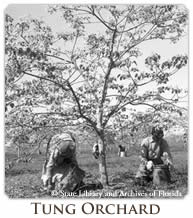 Tung was introduced into the US in the Jefferson County area in 1906. By the late-1950s, there were over 12,000 acres of tung planted in the county, the center of Florida production. Tung mills were located at Jumpy Run, at the southeast edge of Monticello, Tungston at Capps, General Tung at Lamont and at Leon Tung in Tallahassee. Other regions of production centered around Gainesville and Marianna, Fla., Bogaloosa, La., and Poplarville, Miss. Jefferson County production reached its high-water mark with World War II, when imports from China were interrupted. Homer Formsby began his furniture finishes business with a shop in the downstairs bay of the Opera House, based on available tung oils.
Tung was introduced into the US in the Jefferson County area in 1906. By the late-1950s, there were over 12,000 acres of tung planted in the county, the center of Florida production. Tung mills were located at Jumpy Run, at the southeast edge of Monticello, Tungston at Capps, General Tung at Lamont and at Leon Tung in Tallahassee. Other regions of production centered around Gainesville and Marianna, Fla., Bogaloosa, La., and Poplarville, Miss. Jefferson County production reached its high-water mark with World War II, when imports from China were interrupted. Homer Formsby began his furniture finishes business with a shop in the downstairs bay of the Opera House, based on available tung oils.
Tung oil was used in paint, varnish, linoleum and printer's ink. Tung's role as an industrial oil is now filled by soybean oil and many other synthetics. Tung orchards had been lost to late spring freezes, and local mills had closed. Nonetheless, some tung was commercially produced in Jefferson County in the late-1960s and early 1970s. But Hurricane Camille which devastated the Gulf coast regions of Lousianna, Mississippi and Alabama brought an end to the domestic industry. Former tung producer Fred Laukea states, "We tried to truck our nuts to Bogaloosa for a year or two, but it was a lost cause. Price support of 22 cents per pound left us no margin."
All tung orchards in Jefferson County have been abandoned. Most plantings have been bulldozed and the land used for other crops, pasture or timber. Only an occasional escaped tree shows its spring ornamental bloom. The US Department of Agriculture established a Tung Laboratory in Monticello. The building is now the JTPA/Grants office on US 19 South at Waukeenah Street. The lab was the forerunner of the University of Florida IFAS Agricultural Research Center, now located three miles west of Monticello on US 90.
Fred Mahan Drive, US 90 to Tallahassee
The scenic, landscaped corridor linking historic districts in Monticello and Tallahassee is West Washington Street in Monticello, US Highway 90 and Tennessee Street on the west side of Tallahassee. But it is best known as Fred Mahan Drive.
In the late 1920's, Monticello Nursery Company owned by Fred A. Mahan was the second largest pecan and ornamental shrubbery concern in the southeast. Mahan's Monticello Nursery donated plants to the county unemployment relief commission to be used for beatification of highways, churchyards, and cemeteries in late 1932. The Coastal Roads Company of Miami received a $20,175.82 contract from the state road department in 1935 to beautify and improve the highway from Tallahassee to Monticello and to clean up the many dead stumps along the right-of-way across Lake Miccosukee. Fred Mahan donated more plants for this project. The Tallahassee-to-Monticello highway employed 45 common laborers at 30 cents per hour for an average of $39.00 per month.
The donated right-of-way of what became US 90 varies between forty and two hundred feet. Its background, middle and foreground plantings consist of Mahan's donated pyracantha, arbor vitae, flowering crape myrtle, liqustrum and palms. Mahan donated between 35,000 and 40,000 plants along the 25 miles between Monticello and the capital. They were set out over a period of eight years. The highway was officially named the Fred Mahan Drive in 1953, A plaque across from the original site of Mahan's Monticello Nursery (now the location of the Farm Credit Service) marks the beginning of the drive, known for years as one of the most beautiful stretches of highway in Florida. Recent additions of crape myrtles every 100 feet, from the intersection of I-10 and US 90 east of Tallahassee, for 18 miles to the edge of Monticello present a spectacular range of brilliant colors throughout the summer months.
Boots Thomas and Raising the Flag on Iwo Jima
Sgt. Ernest I. ("Boots") Thomas, Jr. was born in Tampa, Florida, on March 10, 1924. His family moved to Monticello when he was a child and he attended public school here. Sgt. Thomas enlisted in the U.S. Marines in 1942, six months after Pearl Harbor. A monument on US Highway 90, West Washington Street in Monticello memorializes Boots Thomas, stating:
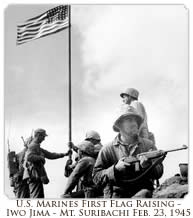 IN RECOGNITION OF PLATOON SERGEANT ERNEST I. THOMAS U.S.M.C.R. WHO ON FEBRUARY 23, 1945, LED HIS PLATOON TO RAISE THE FIRST FLAG ON IWO JIMA, THE FIRST JAPANESE TERRITORY TAKEN IN WORLD WAR II. ON MARCH 3rd, EIGHT DAYS AFTER THE FIRST FLAG RAISING AND TEN DAYS AFTER HE EARNED THE NAVY CROSS FOR HEROISM IN ACTION, HE WAS KILLED LEADING HIS MEN IN COMBAT.
IN RECOGNITION OF PLATOON SERGEANT ERNEST I. THOMAS U.S.M.C.R. WHO ON FEBRUARY 23, 1945, LED HIS PLATOON TO RAISE THE FIRST FLAG ON IWO JIMA, THE FIRST JAPANESE TERRITORY TAKEN IN WORLD WAR II. ON MARCH 3rd, EIGHT DAYS AFTER THE FIRST FLAG RAISING AND TEN DAYS AFTER HE EARNED THE NAVY CROSS FOR HEROISM IN ACTION, HE WAS KILLED LEADING HIS MEN IN COMBAT.
ON FEBRUARY 19, 1945, AFTER MONTHS OF BOMBARDMENT, CULMINATING IN 74 DAYS OF CONTINUOUS AIR STRIKES, THE LARGEST MARINE COMBAT FORCE EVER ASSEMBLED LANDED ON THE EIGHT SQUARE MILE JAPANESE ISLAND OF IWO JIMA. AT THE SOUTHERN TIP A 550 FT. VOLCANO, MOUNT SURIBACHI, WAS ISOLATED THE FIRST DAY. THE BASE OF SURIBACHI WAS SURROUNDED ON D PLUS 3 AND ON THE NEXT DAY AT 10:20 A.M. MARINES FROM COMPANY E.3rd PLATOON RAISED THE STARS AND STRIPES ON ITS SUMMIT. HOURS LATER A PICTURE OF THE SECOND FLAG RAISING WAS TO BECOME THE MOST FAMOUS SINGLE PHOTOGRAPH EVER TAKEN.
ON MARCH 26, FOLLOWING 36 DAYS OF THE BLOODIEST BATTLE IN MARINE HISTORY, THE MOST HEAVILY FORTIFIED ISLAND IN THE WORLD WAS SECURED. THE ISLAND COST 6,821 U.S. MARINE LIVES AND MORE THAN 20,000 ENEMY LIVES. HOWEVER, 2,251 B29 BOMBERS AND THEIR CREWS ULTIMATELY FOUND REFUGE ON BATTLE SCARRED ASH LADEN IWO JIMA.
The monument's face is an etched representation of the Lou Lowery photograph of the first flag raising of Iwo Jima, with Boots Thomas and others Marines: 1st Lt. Harold Schrier, Pl. Sgt. Ernest Thomas , Sgt. Henry Hansen, Col. Charles Lindberg, Pfc. Louis Chanlo and Pfc. James Michels.
Lloyd Railroad Station
The station, built in 1858, is the oldest brick station in Florida. It was given to the Jefferson County Historical Association in 1968 by the Seaboard Coast Line Railroad. It has now been turned over to the Gulfwind Chapter of the National Railroad Historical Society and is open when the site is included in historic Tour. The Lloyd Post Office and the Lloyd Volunteer Fire Department are located there. The station is at the intersection of Highways 59 and 158 in the community of Lloyd.